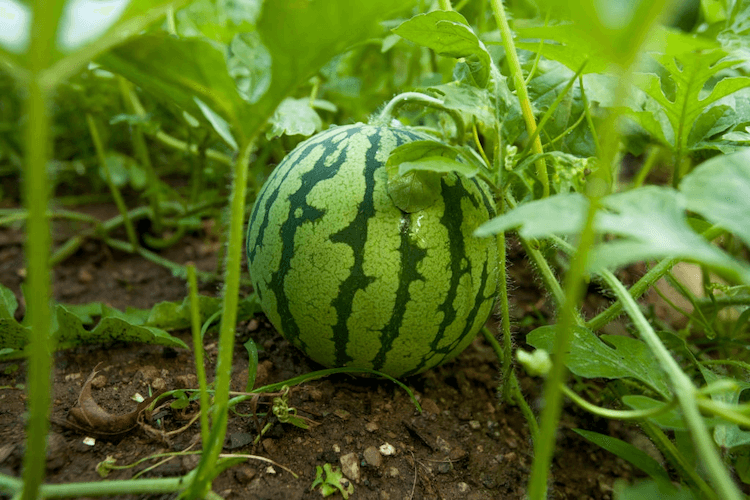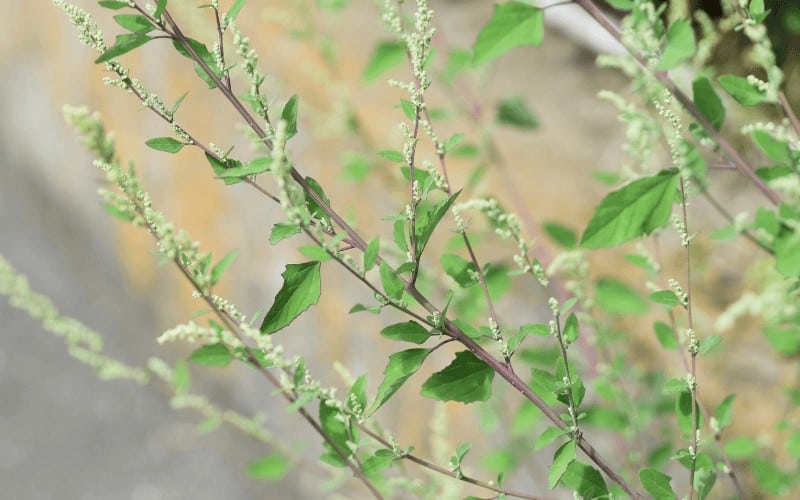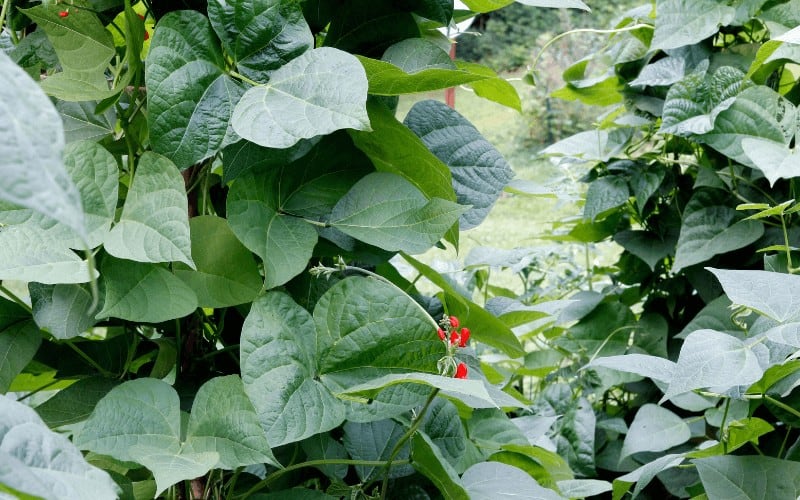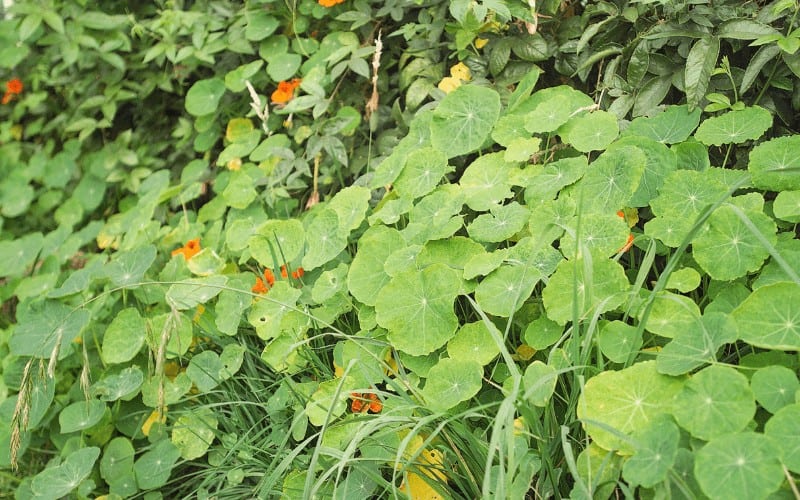If you must grow watermelon with other plants, the first step is to know all the watermelon companion plants so you don't end up inhibiting its growth.
Some of the best companion plants for watermelon are radishes, alliums, corn, lamb’s quarter, pole beans, oregano, potatoes, marigold, and nasturtiums.
In the plant kingdom, watermelons, also known as Citrullus vulgaris, are friendly to almost all the plants and vegetables that abound. But you shouldn’t let their friendliness with other plants and veggies come in the way of them receiving their needed sunlight.
To ensure this, do not grow watermelon alongside any plant that would tower over it and shadow it from optimum sunlight, or you grow the watermelons on A-frame or a trellis.
Table of Contents
Watermelon Size And Sunlight Requirement
You must understand that watermelon needs lots of space, except you want to grow a bush-type. Their vines can reach up to 20 feet in length, and both the small varieties of watermelon such as Sugar Baby and large varieties like Crimson Sweet can spread up to 6 to 8 feet.
It's also worth mention that watermelons need full sun, so you don't want to plant them next to tall crops that can easily cast shade on them.
Having space and sunlight requirements in mind will help you to narrow down the best spots in your garden to grow watermelons.
Now, let's look at some of the best companion plants for watermelon. In the end, we'll also look at what not to plant with watermelon.
Best Watermelon Companion Plants

Some watermelon companion plants give definite benefits more than the others, and we shall be looking into some of them below.
1. Radishes

Radishes are beneficial watermelon companion plants because they repel insect pests that attack watermelon.
Cucumber beetles are significant pests that attack watermelon, and when they are left untreated, they go ahead to transmit bacterial wilt to watermelon. Bacterial wilt causes watermelon to wilt and die immediately when fruit production begins.
2. Lamb’s Quarter

Lamb’s quarter, also known as Chenopodium album, is a weed, but we would call it a beneficial weed at this point.
Lamb’s quarter, when allowed to grow alongside watermelon, improves its vigor and amount of minerals in watermelon. Lamb’s quarter is rich in several nourishing minerals.
3. Bush or Pole Beans

Planting bush beans or pole beans alongside watermelon can have a good effect on watermelon. Beans and other leguminous plants like peas increase the soil’s nitrogen by fixing nitrogen in the air.
This leaves watermelon with abundant nitrogen and other nutrients to thrive.
Read Also: What Not to Plant with Tomatoes
4. Alliums

Alliums are a family of garlic, chives, shallots, leeks, and onions. Alliums, when planted around the watermelon, help improve the health and vitality of watermelon by repelling insect pests that attack it.
Pests that attack watermelon include flea beetles, whitefly and black fly, and alliums repel all of them.
5. Oregano

Oregano is an aromatic herb that improves the health of watermelon when planted around it.
Oregano has a strong smell that masks the presence of watermelon plants from harmful predators, while it attracts excellent pollinators like hoverflies and lacewings.
The watermelon vine needs its pollinators to produce the best fruit. Bees that flit from flower to flower along the watermelon’s vines are responsible for fruit development.
6. Corn

Corn plants are beneficial to watermelon. Both crops have different pests and diseases, and as a result, when planted together, they help each other conceal themselves from dangerous pests and thrive.
Additionally, watermelons are liable to burn in the midday heat, even though they require about six hours of sunlight per day.
Planting corn around watermelon helps provide shade to watermelon during the hottest times of the day, thereby ensuring that watermelon heads do not die off from excess heat.
While co-planting corn and watermelon ensure that the corn isn’t shadowing over the watermelon.
7. Marigold

Marigolds of the ‘Tagetes’ order are beneficial to watermelon when planted as companion plants. Marigolds have the ability to ward off pests that attack watermelon.
Marigolds contain a substance called ‘Alpha- terthienyl,’ which repels pests and disease-causing microorganisms.
8. Potatoes

Potatoes are useful companion plants to watermelon. Potatoes have tremendous effects on watermelon when they (potatoes) are mulched with straws.
Straws help in lowering soil temperatures and increasing soil moisture. It (straws) also helps in controlling weed growth and pest invasion.
Therefore, when potatoes mulched with straws are planted in the company of watermelon, the watermelon is less susceptible to attacks from insect pests and weeds.
9. Nasturtiums

Nasturtiums, popularly known as garden nasturtiums and scientifically known as ‘Tropaeolum majus,’ are useful companion plants for watermelon and a wide range of other garden plants.
Nasturtiums, when planted alongside melons, help keep insect pests away from the plant by repelling insects like aphids and squash bugs. They also attract beneficial insects like bees and ground beetles.
10. Plants That Attract Pollinators

Watermelon flowers are not attractive to pollinators; hence watermelon plants need plants that attract pollinators to be planted around it.
Planting attractive plants around watermelon increase the chances of watermelon getting pollinated.
Some of the attractive plants that could aid the pollination of watermelon include cosmos, zinnias, and alyssum.
Also, members of the aster families like sunflowers, coneflowers, and daisies are good at attracting pollinating insects.
What Not to Plant With Watermelon

While we have learned that watermelon is friendly to almost all plants and vegetables, there exist some plants that are detrimental to the optimal growth and development of watermelon.
These plants should not be grown alongside or anywhere near to watermelon plants.
Some of these plants include;
1. Black Walnut Tree
Black walnut trees are detrimental to watermelon, especially when watermelons are trying to produce fruits.
The black walnut tree contains a substance known as ‘juglone’ that stunts the growth of watermelon and other low root vegetable plants like cabbage. Juglone also stops watermelon seeds from germinating properly.
Shagbark hickory tree is another plant that has a similar effect of a black walnut tree on watermelon. It also contains juglone. Both tree plants should be grown far away from watermelon and other vegetable plants.
2. Watermelon
Watermelon is also its enemy. Watermelon can be detrimental to its growth and development if its vines are allowed to stumble across each other.
When watermelon and other plants are planted too close to each other, they can choke themselves and result in stunted growth.
To avoid this, ensure to plant watermelon in a well-spaced out space with adequate room for its roots and vines.
Ensure a minimum of 6 ft and a maximum of 10 ft are left between each watermelon plant. When adequately spaced out, watermelon thrives very well and produces healthy fruits.
3. Cucumbers and Zucchini
Some vegetables like cucumbers and zucchini are not supposed to be planted alongside watermelon, because they attract pests to watermelon. They attract pests like cucumber beetles and aphids to watermelon.
These pests feast on watermelon’s leaves and flowers; they also sap sweetness from leaves and affect the overall growth and fruit development of watermelon.
Frequently Asked Questions
What should you not plant next to watermelon?
Some of the things you should not plant next to watermelon are cucumbers, pumpkins, summer squash/zucchini, and winter squash.
What grows well with watermelon?
Flowering plants with appealing scents such as lavender, marigolds, corn, borage, and alliums are good companion plants for watermelon. These help to repel aphids, which can destroy watermelon leaves and tendrils.
Can you plant corn and watermelon together?
Yes, you can plant corn and watermelon together, but remember that watermelon plants need full sun to survive. So, the corn should not be allowed to tower over the vines too much.
Are watermelon and tomatoes companion plants?
Yes, watermelons and tomatoes can grow well together under the same temperature, nutrition, sun, and water needs; however, they require adequate spacing for healthy growth.
Can watermelon and zucchini be planted together?
No, zucchini is not a good companion plant for watermelon as it can attract different species of aphids, including melon aphids.
What is the best month to plant watermelon?
We recommend you plant watermelon from late spring to early summer when the soil temperatures get to 70° F or above.
Can pumpkins be planted next to watermelon?
Yes, you can plant pumpkins and watermelons together, but you must be generous in their spacing; else, they will not grow well together.
What happens if you plant watermelons too close together?
Watermelons planted too close together will generally compete for soil nutrients, sunlight, and air, which will lead to a potentially compromised crop.
Can you plant strawberries with watermelon?
Yes, you can plant strawberries together with watermelons. They need a minimum of 6 to 8 hours of direct sunlight per day for healthy growth.
Can you plant watermelon next to cantaloupe?
Yes, you can plant watermelons and cantaloupes together, but you must give them enough spacing in the garden bed. And you must remain very conscious about monitoring the plants for weeds, disease and pests.
Related Posts:
- What Not to Plant with Kale
- Turnip Companion Plants
- Sweet Potato Companion Plants
- Fast Growing Ground Cover For Slopes
- Eggplant Companion Plants
- Can You Plant Tomatoes and Cucumber Together?
Conclusion | Companion Plants For Watermelon
Watermelon is such an exotic plant to have in your garden or your planting pot. Watermelon offers a good dose of antioxidants low in calories and a good amount of vitamin c.
Planting watermelon, whether on a small scale or large scale, alongside companion plants, helps the plant thrive well. Be sure to incorporate one or more watermelon companion plants to your garden.





Leave a Reply